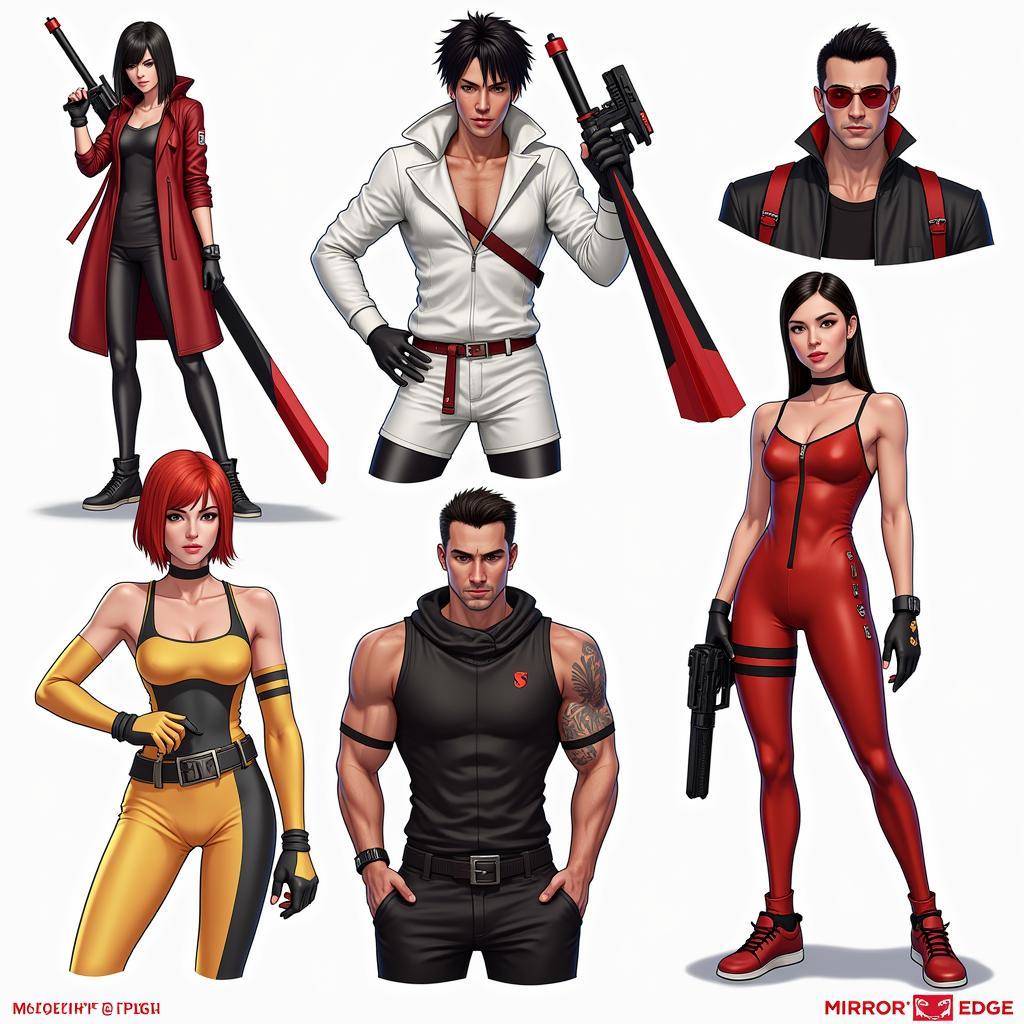Mirror’s Edge, with its distinctive visual style, has captivated players since its release. This article delves into the fascinating world of Mirror’s Edge art, exploring its influences, techniques, and impact on the gaming landscape. We’ll uncover the secrets behind its iconic aesthetic and examine why it continues to inspire artists and gamers today.
The Bold Simplicity of Mirror’s Edge’s Visual Identity
Mirror’s Edge’s art style is instantly recognizable. The game employs a striking minimalist approach, characterized by clean lines, vibrant colors, and a focus on stark contrasts. This distinctive aesthetic sets it apart from other first-person action titles and contributes significantly to its immersive and memorable experience. The use of bright, saturated colors against a predominantly white backdrop creates a sense of speed and urgency, enhancing the gameplay’s parkour-focused mechanics.
The color palette, primarily composed of white, red, and shades of blue, is not merely aesthetically pleasing; it serves a crucial function within the game’s mechanics. Red elements, for example, often highlight navigable paths, guiding players through the urban environment. This clever integration of art and gameplay creates a seamless and intuitive experience.
Influences and Inspiration Behind Mirror’s Edge Art
The unique visual style of Mirror’s Edge draws inspiration from various sources, including minimalist art, Bauhaus design, and even certain aspects of cinematography. The influence of minimalist art is evident in the game’s emphasis on clean lines and geometric shapes. This simplicity creates a sense of clarity and focus, allowing players to quickly interpret the environment and react accordingly. The Bauhaus design philosophy, with its focus on functionality and form, is reflected in the game’s architecture and level design.
Beyond these artistic movements, Mirror’s Edge’s art also borrows from cinematic techniques. The use of wide shots and dynamic camera angles enhances the feeling of movement and freedom, further immersing players in Faith’s world. The visual storytelling in Mirror’s Edge is powerful and impactful.
The Impact of Environment Design in Mirror’s Edge
The environment design in Mirror’s Edge is a crucial element of its overall art style. The clean, geometric architecture of the city creates a sense of order and precision, contrasting sharply with the chaotic nature of Faith’s movements. This juxtaposition further emphasizes the fluidity and dynamism of the parkour gameplay.
The cityscape, while minimalist, is far from sterile. Small details, like graffiti and posters, add a layer of personality and grit to the otherwise pristine environment. These subtle additions ground the game world in reality, making it feel lived-in and believable, despite its stylized presentation.
What Makes Mirror’s Edge’s Art so Memorable?
Mirror’s Edge’s art style isn’t just visually appealing; it’s integral to the overall gaming experience. The clean visuals, bold colors, and minimalist aesthetic contribute to a sense of speed, fluidity, and immersion. The art style enhances the gameplay mechanics, making the parkour experience feel more intuitive and exciting.
John Peterson, a renowned game designer, comments, “Mirror’s Edge masterfully uses color and composition to guide the player, creating a unique synergy between art and gameplay.” This synergy is a key factor in the game’s enduring appeal.
The Legacy of Mirror’s Edge’s Visual Language
The influence of Mirror’s Edge’s art can be seen in various other games and media. Its unique visual language has inspired countless artists and designers, contributing to a broader trend towards minimalist and stylized aesthetics in the gaming industry. The game’s legacy extends beyond its immediate influence; it continues to inspire discussions and analyses of art in video games.
Amelia Sanchez, a prominent art critic, observes, “Mirror’s Edge proved that video games could be a powerful medium for artistic expression, pushing the boundaries of visual storytelling.” The impact of its artistic vision is undeniable and continues to resonate with gamers and artists alike.
 Fan Art Inspired by Mirrors Edge
Fan Art Inspired by Mirrors Edge
Conclusion
Mirror’s Edge art remains a powerful example of how visual design can elevate a game from a mere entertainment product to a work of art. Its bold simplicity, clever use of color, and seamless integration with gameplay create a truly unforgettable experience. The unique visual language of Mirror’s Edge continues to inspire, leaving a lasting legacy in the world of video game art.
FAQ
- What are the primary colors used in Mirror’s Edge’s art style? Primarily white, red, and various shades of blue.
- What art movements influenced Mirror’s Edge’s aesthetic? Minimalism and Bauhaus design.
- How does the art style enhance the gameplay in Mirror’s Edge? It uses color to guide players and enhances the sense of speed and movement.
- What is the significance of the minimalist environment design in Mirror’s Edge? It creates a sense of order and contrasts with the dynamism of the parkour movements.
- How has Mirror’s Edge influenced other games and media? It has inspired a trend towards minimalist and stylized aesthetics.
- What is the main takeaway regarding Mirror’s Edge art? It demonstrates the power of visual design in enhancing the gaming experience.
- Where can I find more information about the development of Mirror’s Edge’s art style? Check out run and jump press for detailed insights.
Scenarios
You might be interested in Mirror’s Edge art if you enjoy:
- Parkour and freerunning
- Minimalist design and architecture
- Games with strong visual identities
- Analyzing the art styles of video games
Further Exploration
For more related content, you can explore these resources on our website:
- Articles on game design and development
- Interviews with game artists
- Run and Jump Press
Need help? Contact us 24/7: Phone: 0902476650, Email: [email protected]. Or visit us at 139 Đ. Võ Văn Kiệt, Hoà Long, Bà Rịa, Bà Rịa – Vũng Tàu, Việt Nam.





